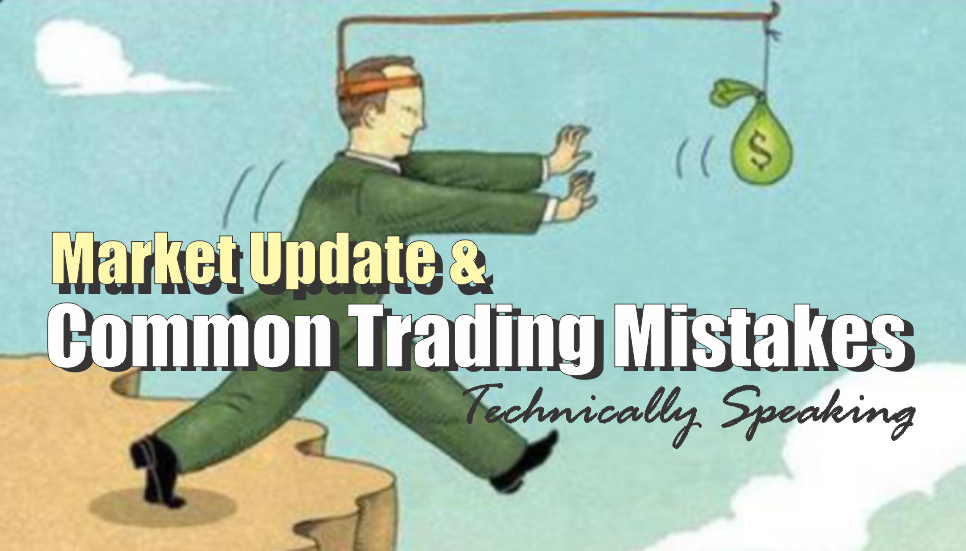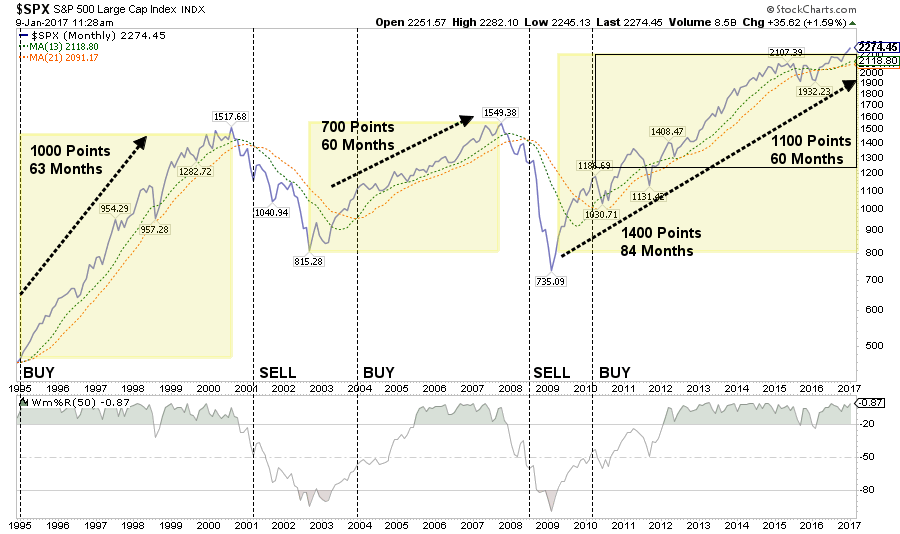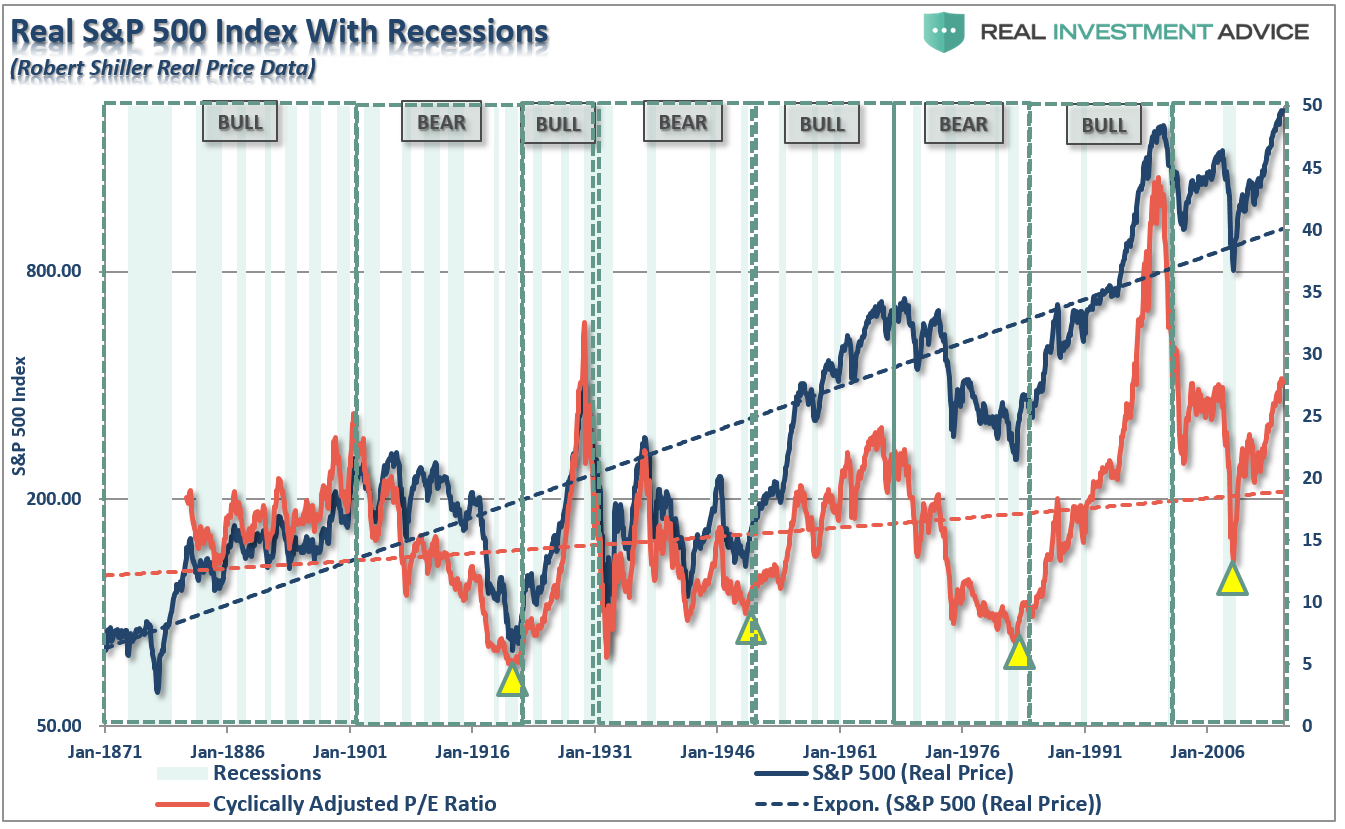As we enter into the first full week of trading since Christmas, the Dow Jones has been unable to attain the magical 20,000 level. While I still suspect this will eventually occur, the challenge has been more difficult that I expected.
I noted in last weekend’s newsletter, “The Problem With Forecasts,” the Dow is currently working on completing an advance of 5000 points over a 24-month span. The last time such a compressed advance occurred was during the 1998-1999 period.
But what about the S&P 500?
Following the 1994 market lull, the S&P 500 began its first serious bull market advance as a wave of investors flooded into the market due to the introduction of online trading and the official opening of the “Wall Street Casino.” From 1995 to its peak in March of 2000 the market advance (whole number basis only) by 1000 points over that 60-month period.
Of course, the subsequent correction of the “dot.com” mania reset the market by roughly 50% of that previous advance.
Following the crash, investors reluctantly began to return to the markets in mid-2003. As the Federal Reserve, and deregulation of Wall Street advanced, so did investors speculation in the markets as a real estate sub-prime lending took hold. Beginning in 2003, the market began a 60-month trek higher of 700-points before once again finding the limits of “fantasy and reality.”
So, here we are once again. Over the last 60-months the markets have advanced by 1100-points, and 1400-points over the last 84 months, as Fed-induced monetary stimulus and suppression of interest rates have once again led investors to believe “this time is different.”
Throughout history, as shown in the chart below, prices have ALWAYS, and I repeat ALWAYS, eventually found their limits. There has never been a “permanently high plateau” that inoculated investors from devastating consequences of misconceived and poorly managed investments.
Importantly, as you will note above, whenever prices have had extreme deviations from the underlying long-term growth trend, as we have currently, the resolution of those excesses were never accomplished by just a “reversion TO the mean.”
With the markets, and the economy, currently pushing the historical limits of time and distance, the reality of an unexpected mean-reverting event has risen in recent months. While such a statement does not imply that a correction will occur immediately, or even within the next few months,
Since I covered “Curing The Trading Addiction” yesterday, which were more general concepts of money management, I wanted to follow up with the specific actions we take which lead us to poor outcomes over time.
Common Trading Mistakes
Many of these are related and are part and parcel of the same refusal to pay proper attention to risk management. If you recognize your own actions in some of these, join the club. Over the years, I’ve committed every sin on the list at least once. Still do on occasion.
1) Refusing To Take A Loss – Until The Loss Takes You.
When you buy a stock it should be with the expectation that it will go up – otherwise, why would you buy it?. If it goes down instead, you’ve made a mistake in your analysis. Either you’re early, or just plain wrong. It amounts to the same thing.
“There is no shame in being wrong, only in STAYING wrong.”
This goes to the heart of the familiar adage: “let winners run, cut losers short.” Nothing will eat into your performance more than carrying a bunch of dogs and their attendant fleas, both in terms of actual losses and in terms of dead, or underperforming, money.
2) The Unrealized Loss
From whence came the idiotic notion that a loss “on paper” isn’t a “real” loss until you actually sell the stock? Or that a profit isn’t a profit until the stock is sold and the money is in the bank? Nonsense!
“Your portfolio is worth whatever you can sell it for, at the market, right at this moment. No more. No less.”
People are reluctant to sell a loser for a variety of reasons. For some it’s an ego/pride thing, an inability to admit they’ve made a mistake. That is false pride, and it’s faulty thinking. Your refusal to acknowledge a loss doesn’t make it any less real. Hoping, and waiting, for a loser to come back and save your fragile pride is just plain stupid.
Losses are a cost of doing business, a part of the game. If you never have losses, then you are not trading properly. Most pros have three losers for every winner. They make money by keeping the losses small and letting the profits build. You should be almost happy to take a loss. It means that you have jettisoned an underachiever stock and have freed up that dead money to put to better use elsewhere. Take your losses ruthlessly, put them out of mind and don’t look back, and turn your attention to your next trade.
3) If I Bet Big – I Win Big
You also lose big.
Preservation Of Capital Is Paramount. If you run out of chips, the game is over. Most professionals will allocate no more than 2-5% of their total investment capital to any one position.
Even when your analysis is overwhelmingly bullish, it never hurts to have some cash on hand, even if it earns ZERO in money markets. This gives you liquid cash to buy opportunities, but also keeps you from having to liquidate a position at an inopportune time to raise cash for the “Murphy Emergency” (the emergency that always occurs when you have the least amount of cash available – Murphy’s Law #73)
As the market becomes more overbought, overextended, and overvalued, your cash level should rise accordingly. Then as the market gets more oversold and undervalued, you have cash to raise your market exposure. Or rather, “sell high so you can buy low.”
4) Bottom Feeding Knife Catchers
Don’t ANTICIPATE bottoms. It’s almost always better to let the stock find its bottom on its own, and then start to nibble. Just because a stock is down, doesn’t mean it can’t go down even more. Let stocks and markets bottom and top on their own and limit your efforts to recognizing the fact “soon enough.”
“Nobody, and I mean nobody, can consistently nail the bottom tick or top tick. Anyone who says they do, is probably lying.”
5) Dollar Cost Averaging
Don’t do it. For one thing, you shouldn’t even have the opportunity, because you should have sold that dog before it got to the level where averaging down is tempting. The pros average UP, not down. They got to be pros because they added to winners, not losers.
Only advisors without a real investment discipline or strategy, or those just collecting fees for assets under management, promote dollar cost averaging.
6) You Can’t Fight City Hall OR The Trend
The vast majority of stocks, roughly 80%, will go with the market flow. And so should you.
It doesn’t make sense to counter trade the prevailing market trend. Don’t short stocks in strong uptrends and don’t buy stocks in strong downtrends. Remember, real investors don’t speculate – “The Trend Is Your Friend”
If you’re worried about a short-term pullback, simply cut back on your trading, take a few profits, and build up your stash of cash until the squall has passed. There is “NO RULE” that says you have to be invested “all the time.”
7) A Good Company Is Not Necessarily A Good Stock
This is, at heart, a problem with fundamental analysis which will identify great companies but doesn’t take into account market, and investor, sentiment. Combining fundamental analysis, which tells you “what” to buy, with technical analysis, to determine “when” to buy, will help you own a great company which is also a great stock.
8) Chasing Performance
Yes, you can make a quick buck chasing momentum, but you can lose it even quicker. You can never be sure there’s a greater fool coming in after you, and that could make you the “greatest fool” of all.
9) Technically Trapped
Amateur technicians regularly fall into periods where they tend to favor one or two indicators over all others. No harm in that, so long as the favored indicators keep on working.
However, market conditions change which also means the efficacy of your indicators will change. Indicators which work in one type of market, may lead you badly astray in another. You have to be aware of what’s working now and what’s not, and be ready to shift when conditions shift.
There is no Holy Grail indicator that works all the time and in all markets. If you think you’ve found it, get ready to lose money. Instead, take your trading signals from the “accumulation of evidence” among ALL of your indicators, not just one.
10) The Tale Of The Tape
I get a kick out of people who insist that they’re intermediate or long-term investors, buy a stock, then anxiously ask whether they should bail the first time the stocks drops a point or two. More likely than not, the panic was induced by watching the tape, or hearing some talking head on CNBC.
Watching the ticker can be dangerous. It leads to emotional and often hasty decisions. Try not to make trading decisions when the market is in session. Do your analysis and make your plan when the market is closed, then calmly execute your plan the following day.
11 ) Worried About Taxes
Don’t let tax considerations dictate your decision on whether to sell a stock. Pay capital gains tax willingly, even joyfully. The only way to avoid paying taxes on a stock trade is to not make any money on the trade.
“If you are paying taxes – you are making money…it’s better than the alternative”
12) Leave The Guru’s In India
They are everywhere – television, print, radio (including me) and everyone has an opinion. You should not be letting some self-appointed market expert dictate or dominate your trading decisions.
“The media is there to sell advertising not make you money – it is for entertainment.”
The most you should expect, or accept, from folks like me, are market analysis, some tidbits of trading strategies, and a bit of guidance in maintaining a solid trading discipline.
13) Everybody’s A Genius
Don’t confuse genius with a bull market. It’s not that hard to make money in a roaring bull market. Keeping your gains when the bear comes prowling is the hard part.
“The market whips all of our butts now and then, and that whipping usually comes just when we think we’ve got it all figured out.”
Managing risk is the key to survival in the market and ultimately in making money. Leave the pontificating to CNBC. Focus on managing risk, market cycles and exposure.
In the long-run, you will likely be better off.
Lance Roberts is a Chief Portfolio Strategist/Economist for RIA Advisors. He is also the host of “The Lance Roberts Podcast” and Chief Editor of the “Real Investment Advice” website and author of “Real Investment Daily” blog and “Real Investment Report“. Follow Lance on Facebook, Twitter, Linked-In and YouTube
Customer Relationship Summary (Form CRS)
Also Read






















